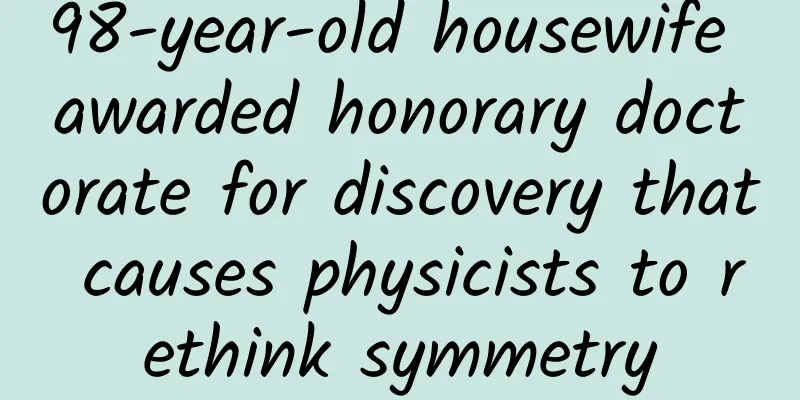98-year-old housewife awarded honorary doctorate for discovery that causes physicists to rethink symmetry

|
Recently, the University of Bristol in the UK awarded an honorary doctorate to 98-year-old Rosemary Fowler. During her doctoral studies, she discovered a particle decay process that was considered strange at the time. This discovery is considered to be "an event that rewrites the laws of physics" and is also the reason why Tsung-Dao Lee and Chen-Ning Yang think about whether parity is conserved. However, Rosemary Fowler left the academic circle due to family reasons, and her outstanding work has rarely been mentioned since then. Now, her alma mater has recognized her contribution on behalf of the world. Compiled by Liu Hang 75 years ago, a seemingly obscure discovery in particle physics caused physicists to rethink the most fundamental symmetries of nature. Its discoverer, Rosemary Fowler (1926-), 98, was recently awarded an honorary doctorate of science by her alma mater, the University of Bristol, after giving up her own doctorate because of her family. Paul Nurse, the president of the University of Bristol and a Nobel Prize winner, personally held a degree awarding ceremony for her. It was in Bristol that her discovery - the decay of K mesons into three pions - eventually triggered a revolution in particle physics theory; Nature magazine described her discovery as "an event that rewrote the laws of physics." Rosemary Fowler awarded honorary doctorate Discovery in cosmic rays The decades before and after World War II were a heyday for particle discovery. In the 1930s, with the discovery of neutrons, muons (second-generation leptons) and the first antimatter particle, the positron, the list of subatomic particles went far beyond electrons and protons. At the time, the University of Bristol had a world-leading cosmic ray physics team. Under the leadership of Professor Cecil Powell (1903-1969), the laboratory perfected the technology of using photographic film to study cosmic rays. Before this, due to the low sensitivity of latex, only some particles with lower energy and higher ionization could be recorded, and particles with higher energy and lower ionization were easily missed, which reduced the chance of discovering new particles. Powell and his collaborators improved the sensitivity of latex and increased the thickness of latex, so that charged particles would be ionized when passing through the latex, and black grains would appear after development and leave tracks. Powell's experimental group is working hard to find new elementary particles from cosmic rays. In 1947, Cecil Powell confirmed the existence of the pion, the lightest particle in the meson family. As early as 1934, Japanese physicist Hideki Yukawa (1907-1981) predicted the pion. Yukawa assumed that protons and neutrons attract each other through a certain field, which is the pion, which acts as a carrier of the strong nuclear force - the residual interaction of the strong interaction. (The meson is composed of a pair of positive and negative quarks, and the strong interaction between quarks is transmitted through gluons.) In December 1947, George Rochester (1908-2001) and Clifford Butler (1922-1999) of the University of Manchester in the UK pushed the study of mesons to a new stage. They carefully analyzed 5,000 cloud chamber photos and discovered a strange particle called theta - an electrically neutral meson that can decay into two pions. A few months later, Rosemary discovered a particle that was very similar to the theta particle. In 1948, 22-year-old Rosemary was a doctoral student in Cecil Powell's group. Her research was to observe photoemulsion photographs exposed to cosmic rays in the high-altitude laboratory on the Jungfraujoch in Switzerland, and to study the high-energy particle reaction process by analyzing the particle tracks in the emulsion photographs. She found something unusual - a strange particle that decayed into three pions. She later recalled: "I immediately realized that this was a new discovery and that it was of great significance. We saw results that we had never seen before." The track she observed was later labeled "k-track" and was evidence of an unknown particle, then called a tau meson. The puzzling thing is that the tau meson should be the mirror image of the theta particle that the Manchester team had seen before, and the two seem to be identical in every way: same mass, same spin, and so on. But they decay in completely different ways: the tau meson decays into three pions, while the theta meson decays into two pions. Rosemary's discovery seemed to break "mirror symmetry," also known as "parity symmetry," where the two processes have opposite parities. The cosmic ray track of the "tau" meson discovered by Rosemary Fowler. The "tau" meson decays to π++π++π- at point A, and the π- then breaks apart at point B. In the early days of particle accelerator development, this method of taking cosmic ray emulsion photos was the main experimental method for studying high-energy particle physics. Rosemary was convinced of her discovery, and the research team carried out an intense period of analysis. "Before publishing this discovery, a lot of measurements and calculations had to be done. We knew it was an important discovery, so we worked very hard to complete everything as quickly as possible." Rosemary said. Rosemary and others wrote three papers in a short period of time, two of which were published in the journal Nature in January 1949. Rosemary was the first author, using her original surname, Brown (R. Brown). This is in line with the convention of alphabetical arrangement of particle physics papers, and also explains her major contribution in this work. It took particle physicists nearly a decade to truly explain this annoying "θ-τ" paradox. Violation of mirror symmetry Before this, people generally believed that the laws of physics were left-right symmetric, that is, the mirror image of any physical process is also a possible physical process. Rosemary's discovery aroused the interest of scientists, who began to study "parity" in more depth, a symmetry that was previously considered to be a fundamental property of nature. In particle physics, parity is expressed in terms of a quantum number that describes how a particle or field behaves when the axes of space are reversed. The total parity is calculated by multiplying the parity numbers of all particles involved at different stages of the process. If parity is conserved, the total parity cannot change. The parity of the pion is -1, and the tau meson discovered by Rosemary decays into a three-meson final state, whose parity should also be -1. But the parity of the two-meson final state of theta decay is +1. If parity is conserved, then the initial particles in the two processes must also have different parities, and therefore should be different types of particles. But no theory can explain why two different types of particles have exactly the same mass. This is the famous theta-tau mystery. Many collaborations followed her lead, carefully studying the cloud chamber photos and sending large quantities of photosensitive emulsion film into the atmosphere using weather balloons to look for signs of tau meson decay. By 1953, physicists had observed 11 events. The Bevatron, a large particle accelerator at Lawrence Berkeley National Laboratory, began operating in 1954 and produced 35 events by 1955. Large particle accelerators provide another important research method for particle physics research besides cosmic rays. In the process, scientists introduced a new naming convention: the first exotic particles discovered were called K mesons, while theta and tau referred to the modes of decay into two and three pions, respectively. Through more precise measurements, the masses of the two types of K mesons were confirmed to be the same, which made the θ-τ mystery even more confusing. In April 1956, particle physicists held a meeting in Rochester, New York to discuss K mesons and several other puzzling strange particles discovered during this period. Although Rosemary and Powell did not attend the meeting, several outstanding scientists such as Murray Gell-Mann (1929-2019) and Richard Feynman (1918-1988) attended the meeting. In Gell-Mann's recollection, Feynman and experimentalist Martin Block (1925-2016) lived in the same room, and Block asked him: "What if parity is not conserved? Can't θ and τ be the same particle?" Feynman also raised this question at the meeting. A photo taken at the School of Physics, University of Bristol. The person leaning against the pillar on the left side of the back row is Rosemary. It turns out that no one can really prove that parity is conserved, especially in the weak interaction process of decay. Tsung-Dao Lee and Chen-Ning Yang also attended that meeting. After careful research, they found that in fact, whether parity is conserved in weak interactions has not been tested. In October of the same year, they published a paper proposing several specific experiments to test whether parity is conserved. At first, their paper was questioned because parity conservation has long been the default view of most physicists; Feynman even bet 50 times the odds against parity non-conservation. In 1956, Tsung-Dao Lee discussed related issues with Chien-Shiung Wu, one of the most authoritative experts in the field of decay in the world at that time, and Chien-Shiung Wu decided to conduct experiments. Due to the importance of the experiment, Chien-Shiung Wu gave up her long-planned trip back to China to visit her relatives, and organized an experimental team with experts from the National Bureau of Standards (NIST) of the United States to start detailed experimental work. By observing the β decay of cobalt-60, they found that most of the final state electrons were emitted in the direction opposite to the polarization direction of cobalt-60. In Wu's experiment, the strong magnetic field polarized the direction of angular momentum, that is, the direction of spin, and in principle did not restrict the direction of motion of the final state electrons. Therefore, if parity is conserved, the final state electrons, that is, the emitted beta rays, should be equally likely in the positive and negative directions of the nuclear polarization direction. However, the experiment only monitored rays in the opposite direction of nuclear polarization, so they could conclude that parity conservation is indeed not valid in weak interactions. (Editor's note: See "Parity Non-conservation and Wu's Experiment That Middle School Students Can Understand") Afterwards, more experimental results followed one after another until parity non-conservation in weak interactions was undeniable. The answer to this puzzle is that the two kaons are the same particle and parity is not a fundamental symmetry of the weak interaction in nature. Wu's experiment was so ingenious that she also managed to show that nature breaks another symmetry - C (charge conjugation) symmetry, which means that if all the particles in an interaction are replaced by their antiparticles, the process should happen in the same way. This discovery made physicists realize that not only parity conservation, but also some other hypothetical symmetries of nature need to be accurately tested. "CP" - the combination of charge conservation and parity conservation, was thought to hold at the time, but was subsequently shown to be violated in a 1964 experiment on kaon decay. CP violation has deeper implications than parity violation, and it may be related to the fact that there is more matter than antimatter in the universe. Abandoning the conservation of parity had a profound impact on physicists. Rosemary's discovery rewrote the development path of particle physics, and people's understanding of elementary particles and their interactions, especially the basic concept of symmetry, has undergone a radical change. Today, physicists are still using various experiments to study symmetry breaking in particle decay and looking for new physics beyond the standard model of particle physics. The Matilda effect Rosemary's story raises the question: Why have so few people heard of her? One reason may be that gender equality was hard to come by in most physics departments and in science in general during her time. Powell's lab was an exception. During the war, men were required to serve in the military, and the new scientific method Powell was using in his lab was being developed: imaging cosmic rays using emulsion technology, a labor-intensive process. Powell's lab collected a large number of cosmic ray photographs, and he hired many scanners, most of whom were women, who painstakingly searched through the photos and handed off anything unusual or interesting to physicists for further analysis. Rosemary Fowler was not a scanner. She was one of the few women invited to study for a doctorate in physics, and she received a first-class bachelor's degree - an extraordinary result for anyone, especially in those days. Rosemary showed an outstanding talent for science after school. She was good at mathematics but not very interested in writing, which may have something to do with her father being a British Royal Navy engineer. She became the only girl in her grade to enter university, and finally became Powell's graduate student with a beautiful transcript. Smart and decisive, she took only two days off after joining the group and started working in June 1947. When she discovered the decay of the "tau meson", the first person she told was her doctoral student classmate Peter H. Fowler. "We spent some time observing and thinking, enjoying the moment of discovery. Then I told the others," she said. As the grandson of nuclear physics pioneer Ernest Rutherford (1871-1937) and the son of quantum physics pioneer Ralph H. Fowler (1889-1944; Dirac's mentor), Peter Fowler was a recognized talented young physicist. He was three years older than Rosemary, but entered school a year later than her, and his studies were interrupted by military service. The two of them got married in 1949, and Rosemary decided to leave academia at the same time. With Rosemary's strong support, her husband Peter Fowler achieved a very outstanding career and made important achievements in the experimental detection of cosmic rays. When asked why she left academia after that without completing her PhD, Rosemary's answer was pragmatic. Living in difficult times with food and housing shortages, and with three daughters who needed care and support, she decided that Peter Fowler would continue to work in physics, which she thought was the best arrangement. Rosemary's daughter Mary Fowler recalled: "When I was a child, I wanted to be a physicist. Both my parents were physicists. Physics and research were the talk of the kitchen table! Rosemary influenced all of us - we were all passionate about science and mathematics. No one thought girls couldn't do it." She is now an outstanding geophysicist and has served as the president of Darwin College, Cambridge University. Because Rosemary Fowler has difficulty in moving, the degree awarding ceremony was held at Darwin College, Cambridge. Over time, in various publications, Rosemary's contributions were often attributed to either her husband or Powell. But Powell explicitly acknowledged Rosemary's major contribution to the discovery. But it does seem to be an example of the "Matilda" effect, whereby the contributions of female scientists are often overlooked or attributed to their male counterparts. [The Matilda effect is named after American writer and activist Matilda Joslyn Gage. In 1870, she wrote a pamphlet called Woman as Inventor, which denounced the then-widespread view that women lacked creativity and scientific talent.] Rosemary is not the only scientist whose contribution has been underestimated. Powell won the 1950 Nobel Prize in Physics for discovering pions using the photosensitive emulsion technique, but the contribution of the inventor of the technique, Austrian physicist Marietta Blau (1894-1970), was overlooked, even though she was later nominated for the Nobel Prize by Schrödinger several times; Indian physicist Bibha Choudhuri (1913-1991) also showed evidence of pions in a paper published in Nature during World War II, and her work is even less known than Blau's... Now, 75 years after her discovery, Rosemary has been awarded an honorary doctorate, proving that her important contribution will always be remembered. Special Tips 1. Go to the "Featured Column" at the bottom of the menu of the "Fanpu" WeChat public account to read a series of popular science articles on different topics. 2. Fanpu provides a function to search articles by month. Follow the official account and reply with the four-digit year + month, such as "1903", to get the article index for March 2019, and so on. Copyright statement: Personal forwarding is welcome. Any form of media or organization is not allowed to reprint or excerpt without authorization. For reprint authorization, please contact the backstage of the "Fanpu" WeChat public account. |
Recommend
What are the essential factors for Tik Tok promotion?
From Haidilao to Daancha, Douyin has demonstrated...
No-threshold novel CPS earning money easily, Xiaobai easily earns over 10,000 yuan a month by transferring videos
As a long-term project with a relatively low thre...
iOS 9 Split Screen Multitasking: Picture in Picture (PiP) Quick Start (Chinese Version)
Follow the instructions in this section to use Pi...
The marketing secrets behind Perfect Diary’s explosive success
Seizing the opportunity of the rise of domestic t...
Science Time Machine | How did the “Big Bang” come about?
On April 1, 1948 , Gamow proposed the Big Bang th...
I was healthy, how did I get tuberculosis? | World Tuberculosis Day
March 24, 2025 The 30th World Tuberculosis Day Th...
Two dimensions teach you how to spread high-quality content?
In an era where content is king, the value of hig...
Zhihu operation and promotion: How to quickly occupy the best promotion position on Zhihu?
The traffic matrix is accumulated, not achieved...
iOS WeChat updated to version 8.0.14: Caring mode can be turned on, text and buttons are larger and clearer
On September 26, WeChat iOS version released the ...
Why do plants grow thorns? The answer lies in the Qinghai-Tibet Plateau
The "beauty" of the plant world is ofte...
Year-end review: Top 10 marketing cases that went viral in 2017
It’s the end of the year again, and it’s time for...
You can use Xposed without Root!
Xposed is a well-known framework on the Android s...
Physicists discover first 'triple black hole' - Why is this phenomenon so rare?
Author: Gou Lijun Black holes have always been a ...
Fish's memory is only seven seconds? Fish: You underestimate me!
The concept of "fish only have a memory of s...
Apple product system comprehensive upgrade IOS15 is coming
Recently, there is news that Apple will release t...









